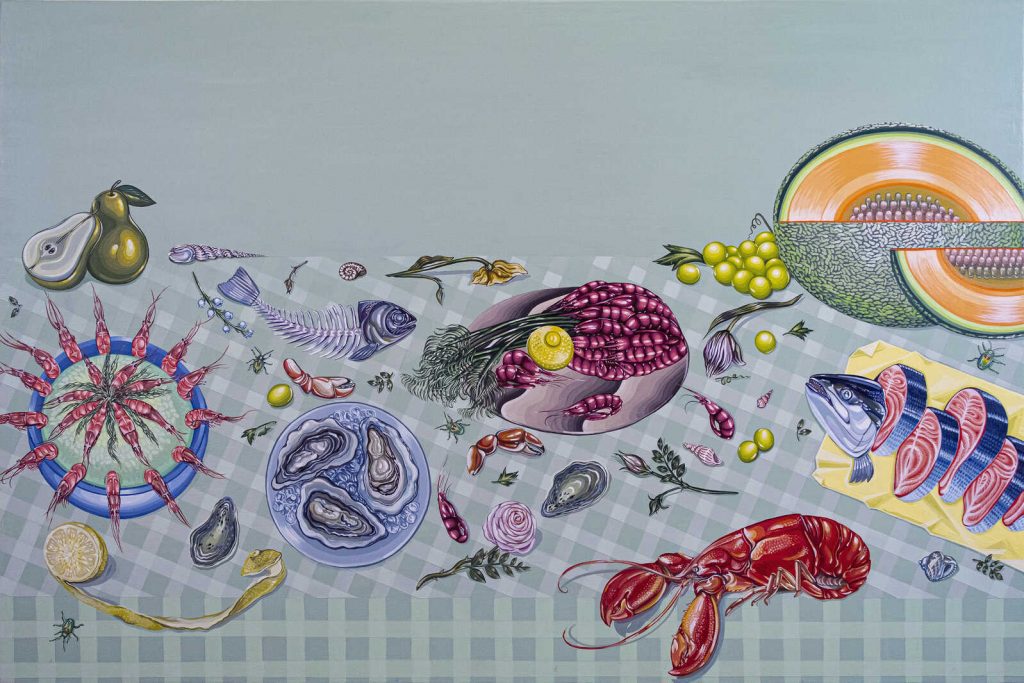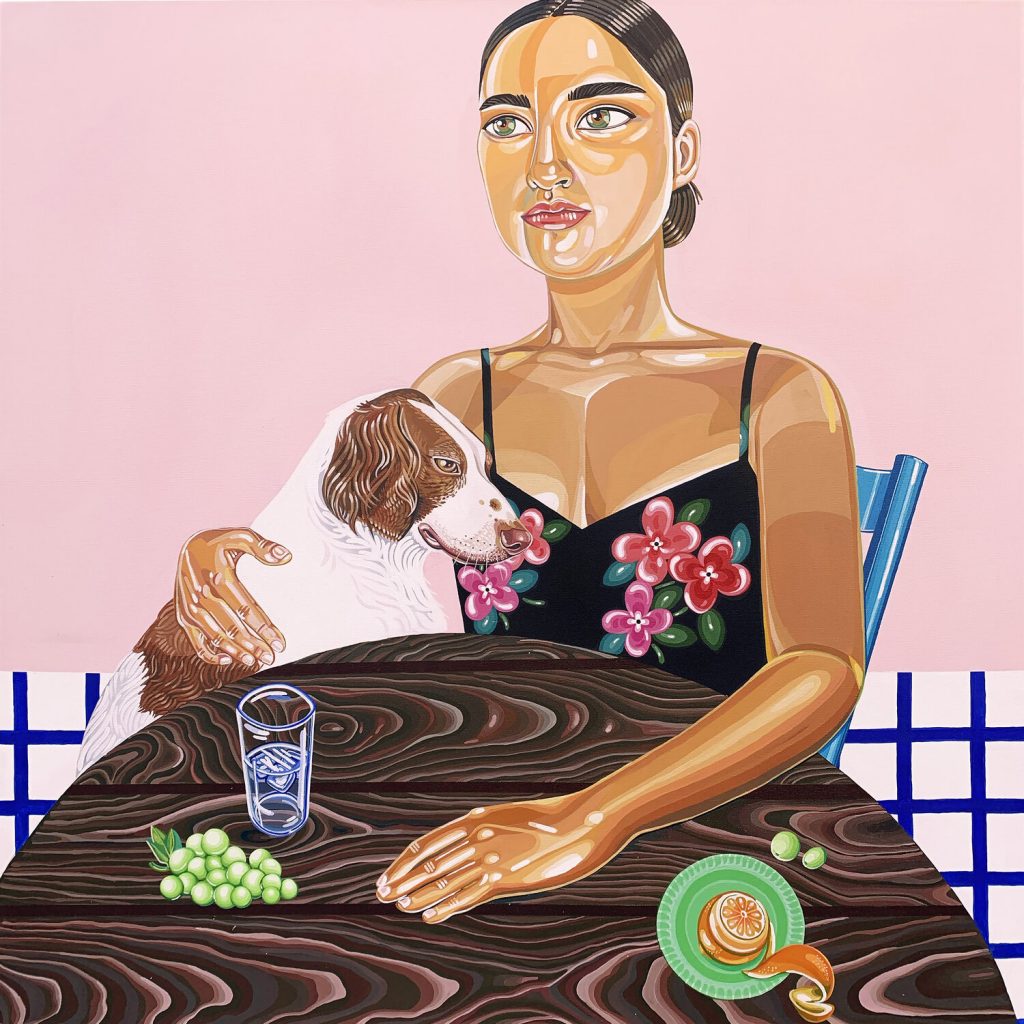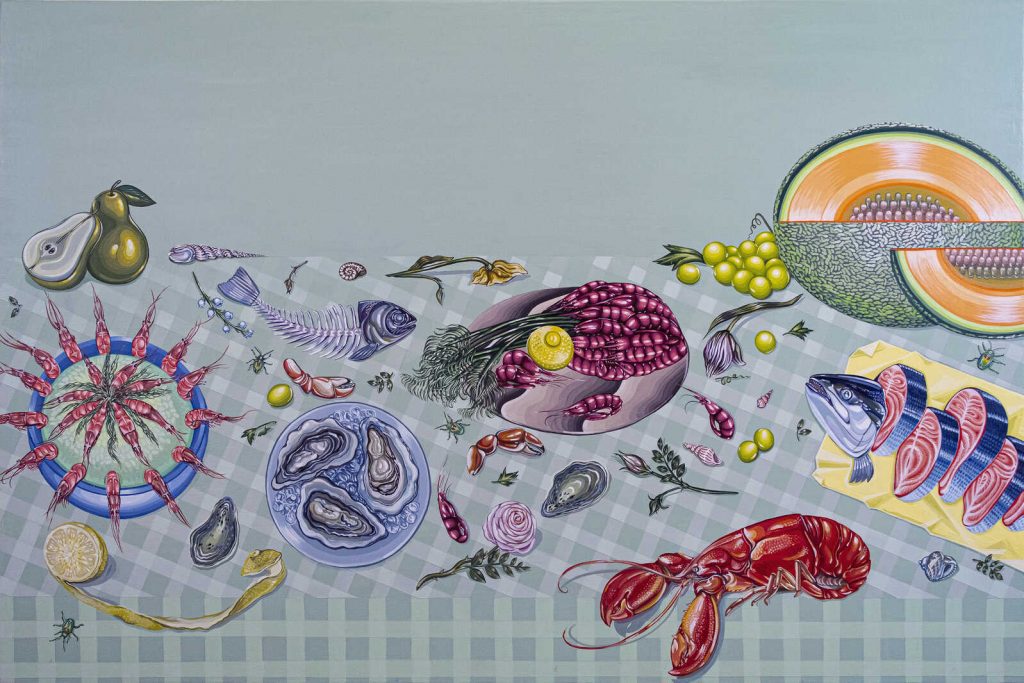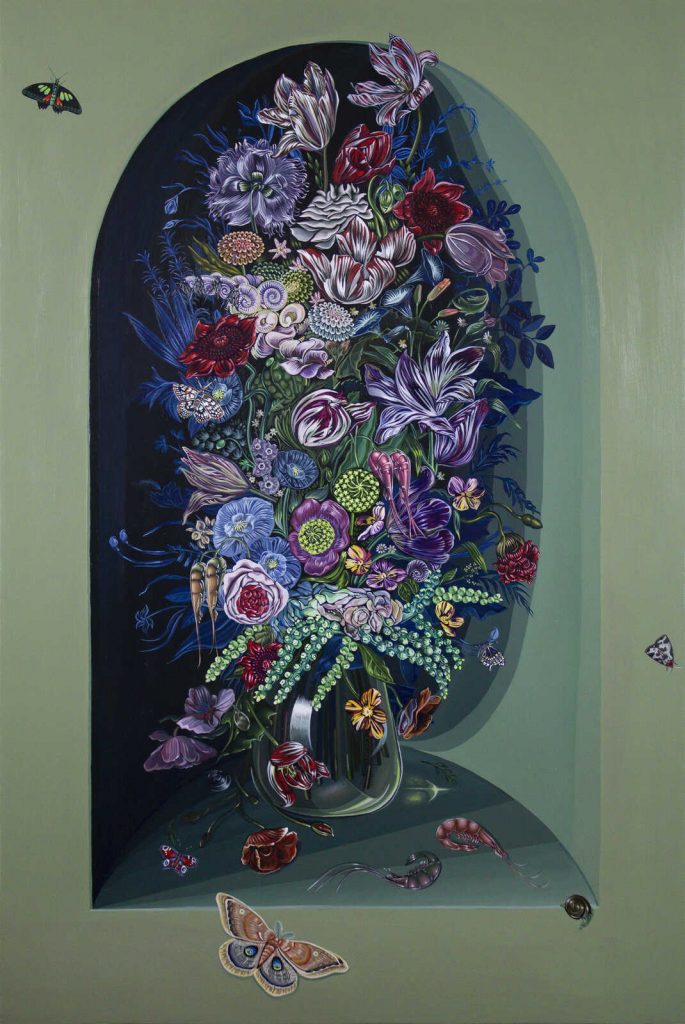Sabrina Bockler (b. 1987) is a self-taught American painter based in Brooklyn, New York, whose work primarily concerns the female figure. Bockler’s playful and colorful approach to painting offers a unique perspective on painting the female form.

The Pescatarian, 2020, Acrylic on wood panel, 24 × 36 in
Tell us a little bit about yourself. Where are you from originally and when did art first enter your life?
I am a second generation American artist, born in New Jersey (1987). My mother is a Polish immigrant and my father is a Jewish American from Canarsie, Brooklyn. In 2011, I received my Bachelors in Fine Arts from Parsons, the New School of Design. I currently live in Brooklyn, New York, with my partner Kevin and our two dogs.
As children, my brother and I would spend our school year in America and our summer months in the small rural town of Kazimierz Dolny, Poland. Unfortunately, my mother never taught us how to speak Polish. This meant our social network was limited to each other and our one English speaking cousin. It also meant a lot of time spent alone. As a child of the 90’s, without access to television, video games, or friends for those summer months, I taught myself how to draw and paint. There wasn’t a lot of access to contemporary art in New Jersey or Kazimierz Dolny. Much of my interest in art was self guided until I was old enough to take museum trips into Manhattan or Warsaw.
Has your work always taken on the style it currently embodies?
There are certain elements of my earlier painting style that I believe have carried through, but it has naturally evolved and changed over time. In part, because my interests and intentions in the way I paint have also changed. My earlier work centered around the figure and creating tension by flattening the depiction of space and perspective. Manipulating the depiction of physical space is something I’m still interested in exploring with my current work, but the figure has been replaced with food, flowers, and fanciful show dogs.

Self Portrait with Louise, acrylic on canvas, 36 x 36 in
What’s a day in the studio like for you?
My day usually begins around 8am, when I feed my dogs and walk the 20ft to my studio room. As a relentless homebody who tends to work long and often strange hours, I’ve found it necessary to have an at-home studio.
Before I begin painting, I will typically get myself situated with three different beverages to keep within reach; coffee, water, a flavored seltzer, and a glass of wine later on. I will take a moment to find a podcast or playlist for background noise. I have been in a long cycle of only binging truly tasteless true crime podcasts while I work. When I find something I like, I have a tendency to overindulge. Once settled, I assess where to begin for the day, put on my gloves, and begin pouring paint.
My dogs, Louise and Rae, will undoubtedly interrupt me wanting to go out. My studio opens to the backyard and they will stare at the door until I comply with their demands. They often remain close while I work and are what I would consider very pleasant studio mates.
I start painting around 9am. It always feels as though I blink and suddenly it’s 4pm. My paintings are incredibly detail oriented, and I often lose track of time. On a good day, I would have taken a break to go out for a mid-day jog. As of lately, I am more and more in the habit of continuing my work into the night and ignoring my other routines. Taking breaks is something I have to actively remind myself to do.
I am trying my best to institute a 6-7pm end of work day to have dinner with Kevin and decompress.
What’s next for you?
I am currently in a group show which opened last week called Wünder Womxn: The Female Figurative, at Beers London. I am in the process of making new work for Basel Miami, where I am showing with Clark Gallery. I have a virtual exhibit for Future Fairs Winter Market, as well as a group show at Hashimoto Gallery in Los Angeles, February 2022 called Potluck.

Ripe, acrylic on wood panel, 24 x 24 in
From where do you draw inspiration?
I am interested in themes of domestic identity and the value (or lack thereof) in what was historically considered women’s work. I often source inspiration from cooking and homemaking magazines from the 1950s/60s. These materials offer a glamorization of domestic servitude and sexism—making a spectacle of it. There’s a contradiction in how we view cooking and celebration as genuine one-to-one expressions of humanity. Oftentimes without acknowledging how domestic tasks historically have been disproportionately gendered.
I wanted to make table-scapes based on the dichotomy between traditional tropes and the uncanny. There’s an interesting tension created when referencing 17th century dutch still life for composition and palette in the context of these unsettling aesthetics. It can be quite uncomfortable when you expect a traditional floral motif and discover stemmed crustaceans upon closer investigation.
Using show dogs in placement of the figure furthers this narrative. There’s something unnatural about the pageantry of purebred dogs. To me, it echoes Stepford Wives. Commodified and engineered to meet certain aesthetic standards, they feel more like objects decorating the home.
What source material do you base your work off of?
I collect vintage magazines and cookbooks. I have annual collections from the 1950s-80s of The American Home, House Beautiful, Betty Crocker, Pillsbury, and Playboy.
Does your work reference any Art Historical movements?
I often refer to Golden Era Dutch still life artists such as Balthasar van der Ast, Ambrosius Bosschaert, Rachel Ruysch, and so on. I am also interested in the artists who belonged to the New Objectivity movement, such as Franz Sedlacek, Christian Schad, and Aenne Biermann.

Indistinct Chatter, 2021, Acrylic on linen on panel, 35 4/5 × 24 in
What is your process like? How do you begin a work?
I write down loose ideas and sketches, but I prefer to leave them rough and open ended rather than fully rendered studies. I find if I rely too heavily on sketches or plan out every element of the painting beforehand, I feel beholden to it and that can be restrictive. Much of my process is instinctive and develops as I go. I prefer to approach a painting with the idea, main subject matter, and color palette fleshed out, then grow the painting from there. My paintings take several weeks to produce. Being receptive to emerging ideas as the painting takes form allows me to engage with the process more intuitively.
At the end of every interview, we like to ask the artist to recommend a friend whose work you love for us to interview next. Who would you suggest?
I would love to recommend my friend Charles Sommer. His series of dense graphite drawings are otherworldly. As an abstract artist, I really admire the way he is able to create texture with graphite and connect divergent elements of space in such a sophisticated way.